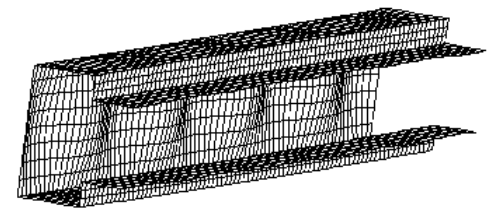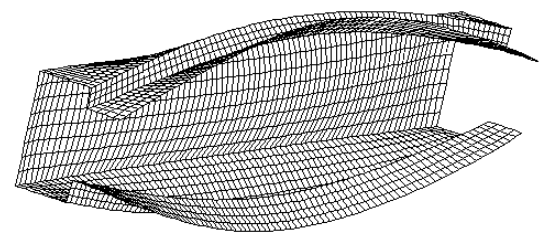
engineering & technology publications
ISSN 1759-3433
PROCEEDINGS OF THE SIXTH INTERNATIONAL CONFERENCE ON COMPUTATIONAL STRUCTURES TECHNOLOGY
Local Buckling, Post-Buckling and Mode Interaction Finite Element Analyses in Cold-Formed Steel Members
+Civil Engineering Program, COPPE, Federal University of Rio de Janeiro, Brazil
*Civil Engineering Department, IST, Technical University of Lisbon, Portugal
In the presence of relevant mode coupling and/or spread of plasticity effects, the "exact" structural behaviour of thin-walled steel members can only be determined by employing sophisticated numerical methods, such as the FEM, which require a computer power only routinely available in (well equipped) research institutions. Although this situation is rapidly changing, as attested by the number of commercial computer codes which are now readily available to perform complex geometrically and physically non linear structural analyses, it was only recently that it became feasible to use FEM analyses to investigate local buckling effects in slender thin- walled members. They will be very useful to validate and/or calibrate easy-to-use design methodologies, thus paving the way to a progressive replacement of several experimental tests by much more convenient computer simulations. Moreover, the above design methodologies are only rational (physically based) and efficient if the member local-plate and/or distortional post-buckling behaviour are accurately known.
This paper presents, discusses and illustrates the application and efficiency of an unified approach to the use of FEM analyses to investigate the local buckling, post- buckling and mode interaction behaviour of cold-formed steel thin-walled members, both in the elastic and elastic-plastic ranges. Initially, a number of relevant modelling and numerical implementation issues are briefly addressed, namely related to (i) the finite element and mesh discretisation choice, (ii) the incorporation of the initial geometrical imperfections, (iii) the modelling of the local boundary conditions or (iv) the numerical solution techniques. Next, in order to assess how the FEM approach is able to handle the aforementioned problems, several aspects dealing with the non linear structural behaviour of rack section members are investigated. At this point, one should mention that all the numerical results displayed are obtained by means of analyses performed using the commercial code ABAQUS [1]. Moreover, in order to validate such FEM results, some of them are compared with values available in the literature, most of which have been obtained by means of finite strip analyses. The different types of (non linear) analyses dealt with are:
- (i)
- Elastic buckling (linear stability) analyses, involving the solution of standard eigenvalue problems and yielding critical stress values and buckling mode configurations. Attention is paid to the influence of the applied stress distribution and local support conditions.
- (ii)
- Elastic and elastic-plastic local post-buckling analyses, concerning members
which bifurcate in either the local-plate or distortional buckling
modes. Such analyses (ii
 ) account for the influence of initial geometrical
imperfection, (ii
) account for the influence of initial geometrical
imperfection, (ii ) can only be performed by resorting to incremental-iterative
numerical techniques and (ii
) can only be performed by resorting to incremental-iterative
numerical techniques and (ii ) lead to the determination of non linear (post-
buckling) equilibrium paths, which relate the evolutions of the applied stress
value and the displacement component better suited to describe the member
deformed configuration.
) lead to the determination of non linear (post-
buckling) equilibrium paths, which relate the evolutions of the applied stress
value and the displacement component better suited to describe the member
deformed configuration. - (iii)
- Elastic and elastic-plastic (local) mode interaction analyses, concerning the
behaviour of members with similar local-plate and distortional buckling stress
values. Such analyses also yield non linear equilibrium paths and particular
attention is paid to identifying (iii
 ) the configuration of the (elastic) coupled
buckling mode and (iii
) the configuration of the (elastic) coupled
buckling mode and (iii ) the nature of the elastic-plastic deformed configuration.
) the nature of the elastic-plastic deformed configuration.
- 1
- Hibbit, Karlsson and Sorensen Inc., "ABAQUS Standard" (Vrs. 5.8), 1998.
purchase the full-text of this paper (price £20)
go to the previous paper
go to the next paper
return to the table of contents
return to the book description
purchase this book (price £125 +P&P)

